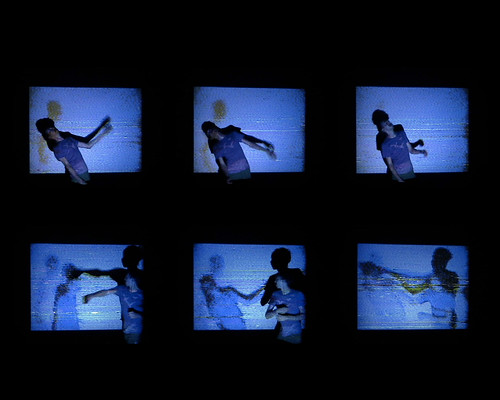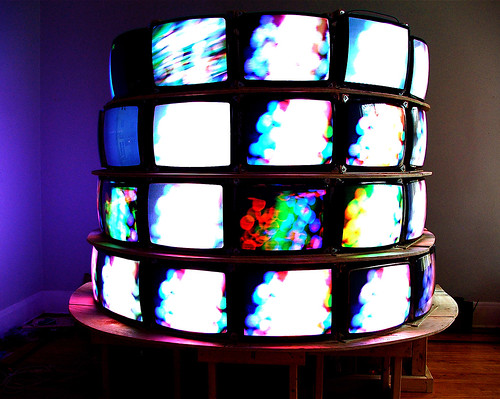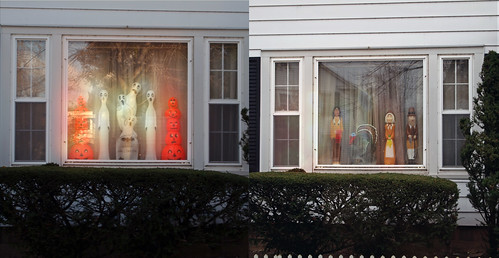
Above: Neil Gravander,
Punch-Yourself-In-The-Face Machine, 2011
(Photo Courtesy of Lynden Sculpture Garden)
The biggest news here at The Famous Hairdos of Poplar Music/Lemon o Books in a month of big news and activity is the publication of
Actual Bird Song.
Actual Bird Song is a collaborative art project comprising a short zine and a 30-minute CD featuring sound collages, both inspired by birds and bird song. You can read the original post unveiling this long-brewing project
here.
I made the book, and I've yakked about that at some length already, but the audio side of the project hasn't been featured as much. The CD features two tracks, the first by Lucky Bone and the second by Slow Owls. These two Milwaukee musicians took actual bird songs (well, recordings of actual bird songs) and used them as raw material to create audio collage. I would like to write here about Lucky Bone and his current art projects and then abruptly grind gears to express some ideas about how his work might relate to my own book projects.
Lucky Bone is the alias for the sound-making projects and performances of Neil Gravander. The original, germinal idea for
Actual Bird Song was Neil’s, but it’s amazing that he got his part completed by our self-imposed October deadline. This is not due to any laziness on his part; rather, it's the opposite, because just before our idea was born, he received a grant to make a large art installation. This work is currently on display at the Inova/Kenilworth Gallery here in Milwaukee, and it's quite an accomplishment. You can check it out at 2155 North Prospect Avenue before it comes down December 4th. If you can, you definitely should.
Much of Neil's recent sculptural work uses VCRs and tube TVs, once-ubiquitous electronic devices which are now viewed as obsolete. One fascinating element of this work, besides the pieces' interactivity and sometimes flat-out beauty, is the recognition that they could not have been realized with any other technology. Hearing Neil's tales of scouring Milwaukee-area thrift stores for his materials, I know how specific his parameters could be for the ideal materials for his project. Adam Krause's catalog essay for the installation elaborates on this theme:
E.F. Schumacher popularized the notion of “appropriate technology” – the idea that the latest technology is not necessarily the proper means for achieving one’s ends. What has been deemed obsolete may actually prove to be the best tool for a particular task. Neil Gravander uses supposedly antiquated technologies...to generate sounds and images that could not be realized any other way.
Experiencing Neil’s pieces, there is a certain nostalgic recognition of the original function of the televisions, but the work resists becoming a commentary on our culture’s passive consumption of media. For one thing, many pieces require interactivity to fully function. They are all clearly handmade, often clumsily so, and shrug off didactic meaning by instead calling for the viewer to participate in the sense of play that obviously went into their creation. As Neil writes in his artist statement for the exhibition, “Within the realm of electronics, I know just enough to not get myself killed and to have some idea of what might be possible.” Taking these electronic devices as raw materials (as he did with recordings of bird song for our collaboration), he toyed with them until they unleashed the results he was after.

Above: Neil Gravander,
Colliding Circles: Epileptic Electrons, 2011
(Photo Courtesy of Lynden Sculpture Garden)
Thinking about these ideas led me to ponder my own relation to an electronic device also seemingly at the twilight of its mass utility, the copy machine. This is on my mind especially while trying to promote
Actual Bird Song. Elsewhere, I recently declared that for me this project was either six months or 28 years in the making. I meant to express my extreme pride, the way it formalized all my years of bird obsession, and how I think this is far and away my best book creation. I tend to use the word book way more than zine when describing my work, not out of any antipathy toward zines but because I am concerned with the way in which books (zine or otherwise) function. Some zinemakers are more concerned with the content of their zines outside of its relation to the book form, and this is valid. Others emphasize the handmade and embrace a rough aesthetic (equally valid). I strive to make formally beautiful books, and I do this with a photocopier, creating them with this means of production in mind.
In 1992, when I was eight or nine years old, my father got his first copy machine for his home office, although it was not new when he acquired it. It was a massive machine whose exact color, like much office equipment of its vintage, resides at that unnamable nexus of beige, light gray, and off-white. Or perhaps my memory is untrustworthy, and it was in fact light gray. Today, in 2011, I had to call my mother who confirmed that this copy machine was manufactured by Ricoh. Had she said Xerox, Canon, or Toshiba, I am sure I could have pictured each company’s logo just as easily as Ricoh’s. Believe me, though, that this copy machine was an important part of my life. When it finally broke (my fault, age 18), it was like the death of a family pet.
The arrival of that copy machine in 1992 means that for almost 20 years I have been using photocopiers to make and reproduce artwork. When that first copier arrived at our home, I was immediately trying to convince my dad to let me copy a drawing I had just made on a Post-It note.
As a zinemaker, my work exists in the context of the handmade books and zines that came before me and those being made today. One common conception of zines is that their means (typically they are photocopied, handmade) are a by-product of necessity, and this is not untrue. Photocopying small editions of books has long been a more viable option for many than offset printing and professional binding (although this is becoming less and less true). However, these traits do not guarantee that an artistic compromise was made, as though, if not for poverty, every photocopied book would have been printed through some "better" means. A photocopy is not simply a low-cost reproduction, it is a form of printing with its own intrinsic qualities which can be considered and exploited for artistic effect.
As a kid, my photocopied output was largely confined to making duplicates of drawings. The originals were usually ballpoint pen renderings on sheets of copy paper. I remember showing one of my reproductions to one of my brothers . He said that it looked like a photocopy of one of my drawings, and I didn’t know how to respond. Of course it was. I could not then articulate and maybe I still can't, but I was infected by the joy of seeing something reproduced, of an image duplicated. An ephemeral drawing somehow became more official and more real when reiterated. And my tool was my dad's copy machine.
In the winter of 2005, in my second to last year of college, I used some of my student loan disbursement to purchase my own copy machine. It was a cheap desktop machine made by Canon, that same nameless gray color but much smaller and slower than the old Ricoh and without the ability to reduce or enlarge. Still, I was excited, and I tried to share with friends my excitement to once again have a copy machine in my home. They invariably explained to me, as though breaking bad news, that an all-in-one copier, scanner, printer could be had for up to half what I had paid for my new copier. They didn’t understand the joy of toner. Inkjet prints cannot compare to copies, not because one is superior, necessarily, but because they are produced by very different devices.
Physically, a copy is toner melted to paper with heat and pressure on a cylindrical drum. A copy comes out of the copy machine warm and smelling like a hair-dryer. Photocopiers can make velvety blacks or graphite-like grays, depending on the specific machine or the settings used or the original being copied. They are very limiting in many ways, and limitations, I think, are good for artists. You can’t register with fine accuracy. They print in one color, and that color is almost always black. Successive generations of copies degrade in quality quickly. But having grown up with a photocopier, I know all this, and I know how to make art that I am proud of using these means.
An inkjet printer does many things that a copy machine can do and it does many things better, but this does not mean that one should replace the other, at least as far as an artist should be concerned. If an idea is conceived to be reproduced on a copy machine, it can be beautiful for what it is, not as a compromise to be apologized for. While techniques like letterpress and silkscreen printing are enjoying a revival at the moment, photocopying retains its lowly stature. The photocopy was never state of the art as a printing method. Its primary association is with office work. None of this should invalidate its use for artmaking or limit the scope of what this art can take on. Just as Neil Gravander's art unapologetically utilizes outmoded video technology for its intrinsic technological and aesthetic qualities, an artist who primarily uses a copy machine should hope for his or her work to be encountered on its own terms.
I hope to continue making books, and I am confident that a copy machine will continue to play some part. Maybe one day I will conceive a project that will be produced in some other way, and it will be created with that in mind. In the meantime, please consider checking out
Actual Bird Song, the newest photocopied book from Lemon o Books.





